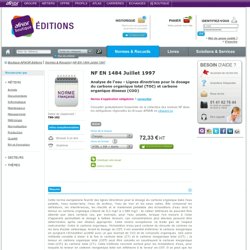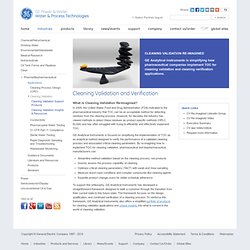

052_054_SOVI789.indd - 052_054_SOVI789.pdf. Boutique.afnor. Résumé Cette norme européenne fournit des lignes directrices pour le dosage du carbone organique dans l'eau potable, l'eau souterraine, l'eau de surface, l'eau de mer et les eaux usées.

Elle comprend les définitions, les interférences, les réactifs et le traitement préalable des échantillons d'eau dont la teneur en carbone organique s'étend de 0,3 mg/l à 1 000 mg/l : la valeur inférieure ne pouvant être atteinte que dans certains cas, par exemple, pour l'eau potable, lorsque l'on mesure à l'aide d'appareils permettant le dosage à faibles teneurs. Les concentrations plus élevées peuvent être déterminées après une dilution appropriée.
Cette norme européenne ne traite pas de l'aspect instrumental. Catalogue SUDOC. Kit de validation de nettoyage TOC. TOC Analysis for Cleaning Validation & Verification. GE Analytical Instruments is simplifying how pharmaceutical companies implement TOC for cleaning validation and cleaning verification applications.

In 2005, the United States Food and Drug Administration (FDA) indicated to the pharmaceutical industry that TOC can be an acceptable method for detecting residues from the cleaning process. However, for decades the industry has viewed methods to detect these residues as product specific methods (HPLC, ELISA) and has often struggled with trying to efficiently and effectively implement TOC. GE Analytical Instruments is focused on simplifying the implementation of TOC as an analytical method designed to verify the performance of a validated cleaning process and associated critical cleaning parameters. Pt0504supp_040_043wall - article.pdf. Untitled - HTTP__3.PDF. Total Organic Carbon Analysis for Cleaning Validation in Pharmaceutical Manufacturing. By Karen A.

Clark, Product Manager, Anatel CorporationOctober 2000 Introduction In the pharmaceutical industry, Good Manufacturing Practices (GMPs) require that the cleaning of drug manufacturing equipment be validated.1 Many different validation techniques can demonstrate that the manufacturing equipment is cleaned and essentially free from residual active drug substances and all cleaning agents. Common analytical techniques in the validation process include HPLC, spectrophotometry (UV/Vis), and TOC. HPLC and UV/Vis are classified as specific methods that identify and measure appropriate active and substances.
The disadvantage of specific methods, particularly HLPC, is that a new procedure must be developed for every active drug substance that is manufactured. TOC analysis can be adapted to any drug compound or cleaning agent that contains carbon and is “adequately” soluble in water. Click on any image for a larger view Methodology Linearity Method Detection Limit and Limit of Quantitation. Total organic carbon. Total organic carbon (TOC) is the amount of carbon bound in an organic compound and is often used as a non-specific indicator of water quality or cleanliness of pharmaceutical manufacturing equipment.

TOC may also refer to the amount of organic carbon in a geological formation, particularly the source rock for a petroleum play; 2% is a rough minimum.[1] For marine surface sediments, average TOC content is 0.5 wt% in the deep ocean, and 2wt% along the eastern margins.[2] A typical analysis for TOC measures both the total carbon present and the so-called "inorganic carbon" (IC), the latter representing the content of dissolved carbon dioxide and carbonic acid salts. Subtracting the inorganic carbon from the total carbon yields TOC. Another common variant of TOC analysis involves removing the IC portion first and then measuring the leftover carbon. Analysis[edit] Environmental[edit] With passage of the U.S. Pharmaceutical[edit] Measurement[edit] GE Analytical Instruments. De plus en plus d’entreprises se rendent compte des avantages que comporte l'analyse COT par rapport aux méthodes traditionnelles portant sur les applications de validation et vérification de nettoyage (CV).

La FDA considère elle aussi que le COT est une méthode acceptable. Elle base ses résultats sur un certain nombre d’études qui démontrent que l'utilisation de l'analyse du carbone organique total (COT) est appropriée lorsqu'il s’agit de mesurer les résidus. (Cliquez ici pour connaître la position de la FDA concernant le COT et la validation de nettoyage). ANALYSEUR COT - VALIDATION DE NETTOYAGE.